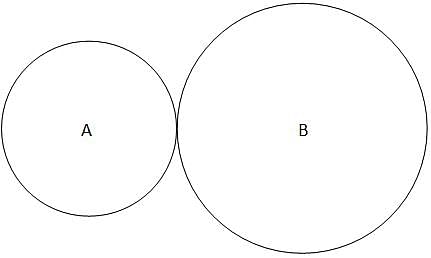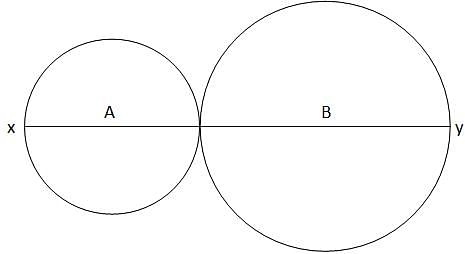GMAT Exam > GMAT Questions > In the above figure, the area of circle A is ...
Start Learning for Free
In the above figure, the area of circle A is 144π and the area of circle B is 169π. If point x (not shown above) lies on circle A and point y (not shown above) lies on circle B, what is the range of the possible lengths of line xy.


- a)0 to 169π2
- b)0 to 144
- c)0 to 25
- d)0 to 50
- e)5 to 144
Correct answer is option 'D'. Can you explain this answer?
Verified Answer
In the above figure, the area of circle A is 144π and the area of c...
- The shortest distance of line xy will occur when x and y are at the same point (i.e., the point where the two circles come together). In this instance, the line xy will be 0 units long.
- In order to determine the longest possible distance for xy, we must first recall that the longest line across a circle is the circle's diameter. In other words, it is impossible to construct a line from one point on a circle to another point on the same circle that is longer than the circle's diameter.
- The longest distance of line xy will occur when x and y are at exact opposite sides of the two circles. In other words, when x is at the far left of A and y is at the far right of B. More technically, line xy will be the combined diameter of circles A and B. This makes sense given that the diameter of a circle is the longest possible line from one point on the circle to another point on the same circle.

- Since the length of xy is the length of the diameter of A plus the diameter of B, we need to find the diameter of each circle.
Area of A = 144π = πr2
rA = 12 = radius of circle A
dA = 2(12) = 24 = diameter of circle A
Area of B = 169π = πr2
rB = 13 = radius of circle B
dB = 2(13) = 26 = diameter of circle B - Maximum distance of xy = 24 + 26 = 50
Most Upvoted Answer
In the above figure, the area of circle A is 144π and the area of c...
- The shortest distance of line xy will occur when x and y are at the same point (i.e., the point where the two circles come together). In this instance, the line xy will be 0 units long.
- In order to determine the longest possible distance for xy, we must first recall that the longest line across a circle is the circle's diameter. In other words, it is impossible to construct a line from one point on a circle to another point on the same circle that is longer than the circle's diameter.
- The longest distance of line xy will occur when x and y are at exact opposite sides of the two circles. In other words, when x is at the far left of A and y is at the far right of B. More technically, line xy will be the combined diameter of circles A and B. This makes sense given that the diameter of a circle is the longest possible line from one point on the circle to another point on the same circle.

- Since the length of xy is the length of the diameter of A plus the diameter of B, we need to find the diameter of each circle.
Area of A = 144π = πr2
rA = 12 = radius of circle A
dA = 2(12) = 24 = diameter of circle A
Area of B = 169π = πr2
rB = 13 = radius of circle B
dB = 2(13) = 26 = diameter of circle B - Maximum distance of xy = 24 + 26 = 50

|
Explore Courses for GMAT exam
|

|
In the above figure, the area of circle A is 144π and the area of circle B is 169π. If point x (not shown above) lies on circle A and point y (not shown above) lies on circle B, what is the range of the possible lengths of line xy.a)0 to 169π2b)0 to 144c)0 to 25d)0 to 50e)5 to 144Correct answer is option 'D'. Can you explain this answer?
Question Description
In the above figure, the area of circle A is 144π and the area of circle B is 169π. If point x (not shown above) lies on circle A and point y (not shown above) lies on circle B, what is the range of the possible lengths of line xy.a)0 to 169π2b)0 to 144c)0 to 25d)0 to 50e)5 to 144Correct answer is option 'D'. Can you explain this answer? for GMAT 2025 is part of GMAT preparation. The Question and answers have been prepared according to the GMAT exam syllabus. Information about In the above figure, the area of circle A is 144π and the area of circle B is 169π. If point x (not shown above) lies on circle A and point y (not shown above) lies on circle B, what is the range of the possible lengths of line xy.a)0 to 169π2b)0 to 144c)0 to 25d)0 to 50e)5 to 144Correct answer is option 'D'. Can you explain this answer? covers all topics & solutions for GMAT 2025 Exam. Find important definitions, questions, meanings, examples, exercises and tests below for In the above figure, the area of circle A is 144π and the area of circle B is 169π. If point x (not shown above) lies on circle A and point y (not shown above) lies on circle B, what is the range of the possible lengths of line xy.a)0 to 169π2b)0 to 144c)0 to 25d)0 to 50e)5 to 144Correct answer is option 'D'. Can you explain this answer?.
In the above figure, the area of circle A is 144π and the area of circle B is 169π. If point x (not shown above) lies on circle A and point y (not shown above) lies on circle B, what is the range of the possible lengths of line xy.a)0 to 169π2b)0 to 144c)0 to 25d)0 to 50e)5 to 144Correct answer is option 'D'. Can you explain this answer? for GMAT 2025 is part of GMAT preparation. The Question and answers have been prepared according to the GMAT exam syllabus. Information about In the above figure, the area of circle A is 144π and the area of circle B is 169π. If point x (not shown above) lies on circle A and point y (not shown above) lies on circle B, what is the range of the possible lengths of line xy.a)0 to 169π2b)0 to 144c)0 to 25d)0 to 50e)5 to 144Correct answer is option 'D'. Can you explain this answer? covers all topics & solutions for GMAT 2025 Exam. Find important definitions, questions, meanings, examples, exercises and tests below for In the above figure, the area of circle A is 144π and the area of circle B is 169π. If point x (not shown above) lies on circle A and point y (not shown above) lies on circle B, what is the range of the possible lengths of line xy.a)0 to 169π2b)0 to 144c)0 to 25d)0 to 50e)5 to 144Correct answer is option 'D'. Can you explain this answer?.
Solutions for In the above figure, the area of circle A is 144π and the area of circle B is 169π. If point x (not shown above) lies on circle A and point y (not shown above) lies on circle B, what is the range of the possible lengths of line xy.a)0 to 169π2b)0 to 144c)0 to 25d)0 to 50e)5 to 144Correct answer is option 'D'. Can you explain this answer? in English & in Hindi are available as part of our courses for GMAT.
Download more important topics, notes, lectures and mock test series for GMAT Exam by signing up for free.
Here you can find the meaning of In the above figure, the area of circle A is 144π and the area of circle B is 169π. If point x (not shown above) lies on circle A and point y (not shown above) lies on circle B, what is the range of the possible lengths of line xy.a)0 to 169π2b)0 to 144c)0 to 25d)0 to 50e)5 to 144Correct answer is option 'D'. Can you explain this answer? defined & explained in the simplest way possible. Besides giving the explanation of
In the above figure, the area of circle A is 144π and the area of circle B is 169π. If point x (not shown above) lies on circle A and point y (not shown above) lies on circle B, what is the range of the possible lengths of line xy.a)0 to 169π2b)0 to 144c)0 to 25d)0 to 50e)5 to 144Correct answer is option 'D'. Can you explain this answer?, a detailed solution for In the above figure, the area of circle A is 144π and the area of circle B is 169π. If point x (not shown above) lies on circle A and point y (not shown above) lies on circle B, what is the range of the possible lengths of line xy.a)0 to 169π2b)0 to 144c)0 to 25d)0 to 50e)5 to 144Correct answer is option 'D'. Can you explain this answer? has been provided alongside types of In the above figure, the area of circle A is 144π and the area of circle B is 169π. If point x (not shown above) lies on circle A and point y (not shown above) lies on circle B, what is the range of the possible lengths of line xy.a)0 to 169π2b)0 to 144c)0 to 25d)0 to 50e)5 to 144Correct answer is option 'D'. Can you explain this answer? theory, EduRev gives you an
ample number of questions to practice In the above figure, the area of circle A is 144π and the area of circle B is 169π. If point x (not shown above) lies on circle A and point y (not shown above) lies on circle B, what is the range of the possible lengths of line xy.a)0 to 169π2b)0 to 144c)0 to 25d)0 to 50e)5 to 144Correct answer is option 'D'. Can you explain this answer? tests, examples and also practice GMAT tests.

|
Explore Courses for GMAT exam
|

|
Signup for Free!
Signup to see your scores go up within 7 days! Learn & Practice with 1000+ FREE Notes, Videos & Tests.
























